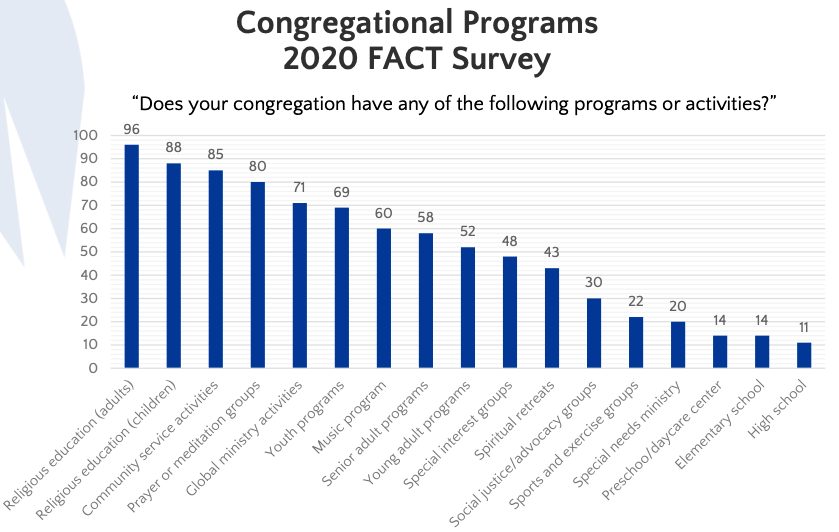Adult and youth education programs were among the most resilient in U.S. congregations during the two decades leading up to the COVID-19 pandemic, while interfaith and ecumenical engagement diminished significantly during that span, according to a new report released by Faith Communities Today.
“The percentage of congregations who participate in interfaith activities has decreased since 2005, particularly regarding interfaith community service activities,” according to the report co-authored by Jessica Williams, FACT Research Liaison for American Baptist Churches USA, and Jeff Woods, ABCUSA general secretary.
“Similarly, congregations participating in activities with other congregations in their same faith tradition decreased from 2015 to 2020.”
The FACT report on congregational programs drew from six studies surveying more than 15,200 congregations in 80 denominations and faith groups dating back to 2000. Other programming categories analyzed in the report included outreach, schools, advocacy, worship services and spiritual practices.
“The 2020 FACT survey shows congregations continue to offer a variety of types of programming for participants of the congregation. … The most emphasized programs were religious education for adults and religious education for children,” according to the summary.
The study found adult education programs were consistently offered by at least 96% of churches, followed by 88% offering children’s religious education. Community service activities (85%) and prayer or meditation groups (80%) exceeded global ministries (71%) and youth programs (69%).

The co-authors also reported declining trends in interfaith and ecumenical engagement among U.S. churches, especially from 2015 to 2020.
Churches involved in worship with other Christian groups declined from 50% to 40% during that five-year period, while ecumenical education and fellowship dropped from about 45% to 37%. Community service ministry fell from about 55% to 44% of U.S. congregations.
“Although involvement with congregations in the same faith tradition decreased from 2015 to 2020, (this) was still significantly higher than that of involvement with other faith groups,” the report said.
In the category of inter-religious activity, participation in joint community services dropped from about 33% of Christian churches in 2005 to only 15% in 2015 and 2020.
Researchers also reported participation in interfaith education and fellowship declined from 20% of churches in 2005 to less than 10% in 2015 and 2020. Similarly, engagement in inter-religious worship dropped from 20% of congregations in 2005 to just under 10% by 2020.

Williams and Woods saw notable correlations between the size of churches, in terms of average weekly attendance, and the kinds of programs they are likely to offer, explaining that the average U.S. congregation has 65 worshippers a week, with 70% reporting 100 or fewer and only 10% reporting more than 250.
Providing meditation and prayer groups was consistent across all church sizes, while the value of young adult and global ministries increased as average weekly attendance increased.
“Congregations with an average weekly attendance of 251 to 500 emphasized adult religious education significantly more than those with attendance over 500,” the researchers said. “It appears that the ‘sweet spot’ for adult religious education seems to be in the medium-large congregations. This is consistent with these faith communities being seen, historically, as ‘program’ congregations.”
Special interest, music and community service programs were less likely to be found in churches with fewer than 100 people in weekly attendance, while spiritual retreats, youth groups, preschools, day care, special needs and similar programs increased in use as weekly attendance rose to 250. “After that point, congregation size did not significantly impact the level of emphasis on these programs,” Williams and Wood said.
The research also found programming distinctives between denominations and faith traditions, such as a Catholic and Orthodox Christian proclivity to offer spiritual retreats and a mainline Protestant preference for special interest (hobbies and crafts) and social justice and advocacy ministries.
Evangelicals gravitated to adult religious education, youth groups and young adult programs.
Evangelicals gravitated to adult religious education, youth groups and young adult programs, while non-Christian groups were more likely to offer prayer and meditation groups.
“There were no significant differences among Christian congregations in offering senior adult programs and preschool/day cares, but Christian congregations were more likely than non-Christian congregations to offer such programming,” the report states.
Average weekly attendance and denominational or faith identity also influenced the likelihood of engaging in ecumenical and interfaith programming, the study found. “Congregations with average weekly attendance of 101 to 500 were significantly less likely than either smaller or larger congregations to engage with other congregations. These mid-sized congregations were less likely to worship, engage in activities, and engage in community service with congregations of the same faith or those of different faiths.”
Evangelical congregations were less inclined to cooperate with other churches or religious groups in worship, fellowship or community service, the report states. “Mainline congregations were most likely to engage in worship and community service with other Christian congregations, while non-Christian congregations were most likely to engage in worship and community service with congregations of other faiths. Non-Christian congregations were more likely to engage in activities with Christian congregations and congregations of other faiths than Catholic and Orthodox churches.”
Williams and Wood also surveyed outreach data collected in 2005, 2008 and 2020. Congregations were asked about the extent to which members are actively involved in recruiting new people to the faith.
Those who responded “some” increased from 40% to 45% from 2005 to 2020. Congregations that said their members engage in outreach “a little” declined from 42% to 30% in the same period, while those who answered “a lot” spiked from 13% in 2005 to 22% in 2008, only to dip to 17% in 2020.
Related articles:
Church religious education took more of a hit than worship during pandemic
Most comprehensive study yet of COVID’s impact on churches finds uneven results


